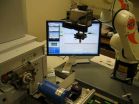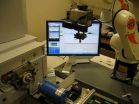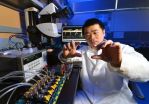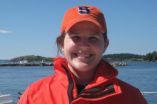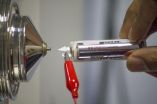(Press-News.org) VIDEO:
In early tests, the research team used a Kuka KR5 sixx R650 robot, seen in action here.
Click here for more information.
When life on Earth was first getting started, simple molecules bonded together into the precursors of modern genetic material. A catalyst would have been needed, but enzymes had not yet evolved. One theory is that the catalytic minerals on a meteorite's surface could have jump-started life's first chemical reactions. But scientists need a way to directly analyze these rough, irregularly shaped surfaces. A new robotic system at Georgia Tech's Center for Chemical Evolution could soon let scientists better simulate and analyze the chemical reactions of early Earth on the surface of real rocks to further test this theory.
In a proof-of-concept study, scientists selected a region for analysis on round or irregularly-shaped objects using a 3-D camera on a robotic arm, which mapped the 3-dimentional coordinates of the sample's surface. The scientists programmed the robotic arm to poke the sample with an acupuncture needle. The needle collected a small amount of material that the robot deposited in a nearby mass spectrometer, which is a powerful tool for determining a substance's chemical composition.
"You see the object on a monitor and then you can point and click and take a sample from a particular spot and the robot will go there," said Facundo Fernandez, a professor in the School of Chemistry and Biochemistry, whose lab led the study. "We're using an acupuncture needle that will touch very carefully on the surface of the object and then the robot will turn around and put the material inside of a high resolution mass spectrometer."
The research was published online February 28 in the journal Analyst, a publication of the Royal Society of Chemistry. The work was supported by a National Science Foundation (NSF) Major Research Instrumentation Program (MRI) grant and by the National Science Foundation (NSF) and NASA Astrobiology Program, under the NSF Center for Chemical Evolution.
Mass spectrometry is a powerful tool for analyzing surface chemistry or for identifying biological samples. It's widely used in research labs across many disciplines, but samples for analysis typically have to be cleaned, carefully prepared, and in the case of rocks, cut into thin, flat samples. The new robotic system is the first report of a 3-D mass spectrometry native surface imaging experiment.
"Other people have used an acupuncture needle to poke a sample and then put that in mass spec, but nobody has tried to do a systematic, three-dimensional surface experiment," Fernandez said. "We are trying to push the limits."
To show that the system was capable of probing a three-dimensional object, the researchers imprinted ink patterns on the surfaces of polystyrene spheres. The team then used the robotic arm to model the surfaces, probe specific regions, and see if samples collected were sufficient for mass spectrometry analysis. The researchers were able to detect inks of different colors and create a 3-D image of the object with sufficient sensitivity for their proof-of-principle setup, Fernandez said.
The research was the result of collaboration between Fernandez's group, which specializes in mass spectrometry, and Henrik Christensen's robotics group in the College of Computing. Christensen is the KUKA Chair of Robotics and a Distinguished Professor of Computing. He is also the executive director of the Institute for Robotics and Intelligent Machines (IRIM) at Georgia Tech.
"The initial findings of this study mark a significant step toward using robots for three-dimensional surface experiments on geological material," Christensen said. "We are using the repeatability and accuracy of robots to achieve new capabilities that have numerous applications in biomedical areas such as dermatology."
"It doesn't happen very often that a group in mass spectrometry will have a very talented robotics group next to them," Fernandez said. "If we tried to learn the robotics on our own it could take us a decade, but for them it's something that's not that difficult."
Christensen's team loaned a Kuka KR5 sixx R650 robot to Fernandez's lab for the study. Afterwards, Fernandez's lab purchased their own robot from Universal Robots. They have also upgraded to a new mass spectrometer capable of resolution nearly eight times higher than the one used in the study. They will soon begin replicating early Earth chemistry on rocks and analyzing the reaction products with their robotic sampling system.
"We really want to look at rocks," Fernandez said. "We want to do reactions on rocks and granites and meteorites and then see what can be produced on the surface."
The technology could also be applied to other research fields, Fernandez said. For example, the robot-mass spec combo might be useful to dermatologists who often probe lesions on the skin, which have distinct molecular signatures depending on if the lesion is a tumor or normal skin tissue.
INFORMATION:
This research is supported by the American Recovery and Reinvestment Act (ARRA) under the National Science Foundation (NSF) Major Research Instrumentation Program (MRI) (Grant number 0923179), and by the NSF and NASA Astrobiology Program under the NSF Center for Chemical Evolution (CHE-1004579). Any conclusions or opinions are those of the authors and do not necessarily represent the official views of the sponsoring agencies.
CITATION: Rachel V. Bennett, et al., "Robotic Plasma Probe Ionization Mass Spectrometry (RoPPI-MS) of Non-Planar Surfaces." (Analyst, February 2014) http://dx.doi.org/10.1039/c4an00277f
Robotic arm probes chemistry of 3-D objects by mass spectrometry
Proof-of-concept study could soon allow analysis of early earth chemistry on meteorites and other rocks
2014-03-25
ELSE PRESS RELEASES FROM THIS DATE:
JCI online ahead of print table of contents for March 25, 2014
2014-03-25
Epigenetic alterations disrupt intestinal T cell homeostasis
A precise balance between mature T cell subsets is important for intestinal homeostasis. Disruption of T cell populations underlies autoimmune colitis, including inflammatory bowel disease (IBD). Specific transcriptional programs are activated to determine the differentiation fate of naïve T cells; however, the role of epigenetic regulation in T cell maturation in the intestine is unclear. In this issue of the Journal of Clinical Investigation, Colby Zaph and colleagues from the University of British Columbia ...
Salamanders shrinking as their mountain havens heat up
2014-03-25
Wild salamanders living in some of North America's best salamander habitat are getting smaller as their surroundings get warmer and drier, forcing them to burn more energy in a changing climate.
That's the key finding of a new study, published March 25 in the journal Global Change Biology, that examined museum specimens caught in the Appalachian Mountains from 1957 to 2007 and wild salamanders measured at the same sites in 2011-2012. The salamanders studied from 1980 onward were, on average, 8% smaller than their counterparts from earlier decades. The changes were most ...
ISU engineer builds instrument to study effects of genes, environment on plant traits
2014-03-25
AMES, Iowa – Let's say plant scientists want to develop new lines of corn that will better tolerate long stretches of hot, dry weather.
How can they precisely assess the performance of those new plants in different environmental conditions? Field tests can provide some answers. Greenhouse tests can provide some more. But how can plant scientists get a true picture of a plant's growth and traits under a wide variety of controlled environmental conditions?
That job has been too big and too precise for most laboratories. There are a few labs around the world that can ...
SU biologists use sound to identify breeding grounds of endangered whales
2014-03-25
Remote acoustic monitoring among endangered whales is the subject of a major article by two doctoral students in Syracuse University's College of Arts and Sciences.
Leanna Matthews and Jessica McCordic, members of the Parks Lab in the Department of Biology, have co-authored "Remote Acoustic Monitoring of North Atlantic Right Whales Reveals Seasonal and Diel Variations in Acoustic Behavior." The article appears in the current issue of PLOS ONE, an inclusive, peer-reviewed, open-access resource from the Public Library of Science in San Francisco, Calif.
Susan Parks, assistant ...
In search of a few good apps
2014-03-25
BOSTON–While the Food and Drug Administration (FDA) has released guidelines for the regulation of mobile health (mHealth) apps that act as medical devices or as accessories to medical devices, the vast majority of mHealth apps remain unregulated and unevaluated. In a Viewpoint article, "In Search of a Few Good Apps", published in JAMA on March 24, 214, co-authors, David Bates, MD and Adam Landman, MD of Brigham and Women's Hospital (BWH) and Adam Powell, PhD, president of Payer+Provider Syndicate, call for the creation of mHealth (mobile health) app review and certification ...
Study: Salamanders shrinking due to climate change
2014-03-25
Wild salamanders living in some of North America's best salamander habitat are getting smaller as their surroundings get warmer and drier, forcing them to burn more energy in a changing climate.
That's the key finding of a new study co-authored by a Clemson University biologist and published Tuesday in the journal Global Change Biology that examined museum specimens caught in the Appalachian Mountains from 1957 to 2007 and wild salamanders measured at the same sites in 2011-2012.
The salamanders studied from 1980 onward were, on average, eight percent smaller than their ...
Nanotube coating helps shrink mass spectrometers
2014-03-25
WEST LAFAYETTE, Ind. — Nanotechnology is advancing tools likened to Star Trek's "tricorder" that perform on-the-spot chemical analysis for a range of applications including medical testing, explosives detection and food safety.
Researchers found that when paper used to collect a sample was coated with carbon nanotubes, the voltage required was 1,000 times reduced, the signal was sharpened and the equipment was able to capture far more delicate molecules.
A team of researchers from Purdue University and the Indian Institute of Technology Madras performed the study, which ...
Model predicts blood glucose levels 30 minutes later
2014-03-25
A mathematical model created by Penn State researchers can predict with more than 90 percent accuracy the blood glucose levels of individuals with type 1 diabetes up to 30 minutes in advance of imminent changes in their levels -- plenty of time to take preventative action.
"Many people with type 1 diabetes use continuous glucose monitors, which examine the fluid underneath the skin," said Peter Molenaar, Distinguished Professor of Human Development and Family Studies and of psychology. "But the glucose levels under the skin trail blood glucose levels from anywhere between ...
NASA satellite sees wind shear whipping Tropical Cyclone Gillian
2014-03-25
A visible image from NASA's Aqua satellite provides a clear picture that wind shear is responsible for weakening the once mighty Tropical Cyclone Gillian from hurricane to tropical storm strength.
When NASA's Aqua satellite flew over Gillian on March 25 at 06:30 UTC/2:30 a.m. EDT, the Moderate Resolution Imaging Spectroradiometer or MODIS instrument took a visible picture of the storm. That image showed that wind shear has pushed clouds and showers away from the center as the storm weakened to a tropical storm.
In the MODIS image, the center of Gillian's circulation ...
Haynes is first to identify cellular patterns of contraction in human hearts
2014-03-25
LEXINGTON, Ky. (March 19, 2014) — When Premi Haynes was growing up in Pune, India, she attended Stella Maris High School, an English language convent school founded by Swiss nuns. Her second grade singing class used a book of English songs. One of the songs was "My Old Kentucky Home." At that time, Haynes had never heard of Kentucky, had no idea where it was, and had no particular ambition to go there.
Some 20 years and a twist of fate later, on March 19 Haynes successfully defended her Ph.D. thesis in physiology at the University of Kentucky, where she's made a significant ...
LAST 30 PRESS RELEASES:
New fossil study illuminates on the evolutionary success of frogs
Patient-specific human liver model to understand disease mechanisms
Confused by the doctor's questionnaire? U of A study suggests it's common
How do brains stay stable, and when might a dose of flexibility be helpful?
mRNA revitalizes aging immune systems—the liver as a fountain of youth
Rural-urban differences in the prevalence of chronic pain among adult cancer survivors
Food insecurity, burnout, and social isolation among resident and fellow physicians
How do spinal cord injuries heal?
Detailed cell map unlocks secrets of how reproductive organs form
Large language models unleash AI’s potential for autonomous and explainable materials discovery
Gut bacteria have evolved rapidly to digest starches in ultra-processed foods
New risk score helps predict pancreatic cancer recurrence
New evidence challenges understanding of Parkinson’s disease
A new study reveals how embryos and the uterus “talk” during implantation
Cedars-Sinai reports heart attacks, general illness spiked after LA fires
PolyU develops ultra-stable, mucus-inspired hydrogel to boost gastrointestinal wound healing
Flour choice shapes sourdough microbial communities
Can a retinal implant reverse macular degeneration?
Feeding fungi plant remnants produces tasty protein to fortify vegan, vegetarian diets
New tech reduces false positives from breast ultrasounds
Drone-mounted lab monitors fertilizer runoff in real time
Short, light-intensity exercise boosts executive function and elevates mood in children
Jeonbuk National University researchers reveal new interface engineering strategy for efficient and stable back-contact solar cells
Tyrosinase drives hydroquinone-induced exogenous ochronosis: not HGD inhibition
UMass Amherst chemists develop unique tool for studying RNA
Disappointment alters brain chemistry and behavior
A built-in odometer: new study reveals how the brain measures distance
Stress-related brain signals drive risk of cardiovascular disease in people with depression and anxiety
New details on role of fat transport molecules in Alzheimer’s onset
Study illuminates how an antiviral defense mechanism may lead to Alzheimer’s disease
[Press-News.org] Robotic arm probes chemistry of 3-D objects by mass spectrometryProof-of-concept study could soon allow analysis of early earth chemistry on meteorites and other rocks
